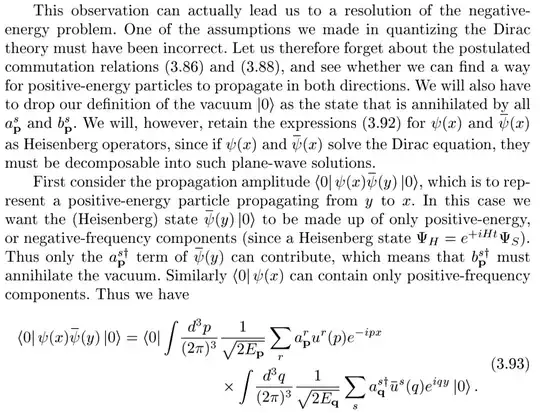From page. 55 and (3.93) of Peskin and Schroeder's An Introduction to Quantum Field Theory:
First consider the propagation amplitude $\langle 0|\psi(x) \bar{\psi}(y)|0 \rangle$, which is to represent a positive-energy particle propagating from $y$ to $x$. In this case we want the (Heisenberg) state $\bar{\psi}(y)|0 \rangle$ to be made up of only positive-energy, or negative-frequency components (since a Heisenberg state $\Psi_H=e^{+iHt}\Psi_S$).
My questions are ---
- In this form $$\langle 0|\psi(x) \bar{\psi}(y)|0 \rangle \sim \langle 0| a_p e^{-ipx} a_q^\dagger e^{ i q y}|0 \rangle$$
It is said to take out only
negative frequency and positive energy component for $a_q^\dagger e^{ i q y}|0 \rangle$.
positive frequency and positive energy component for $ a_p e^{-ipx} ...$
I do not fully understand what is the emphasis here? Is the interpretation here that we only select the positive energy component or state, for a reason?
How about the negative frequency and positive frequency parts? Why does the interpretation of negative frequency and positive frequency matter?
- How is this calculation a resolution of the negative energy problem?
Precisely from this paragraph:
p.s. I found a related but also unsolved post here just now when I am posting myself: Sign of energy and frequency in a propagation amplitude
